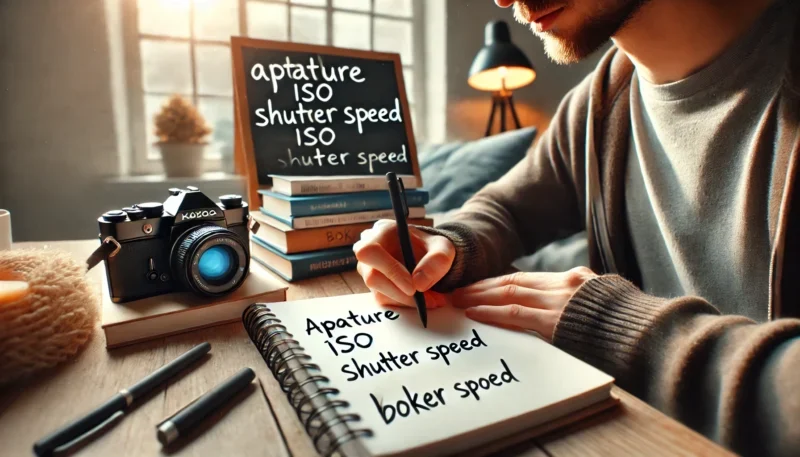If you’re new to photography, the technical language can feel like learning a whole new dialect. ISO, aperture, bokeh, RAW, white balance—what does it all mean?
Understanding these terms is the first step toward mastering your camera and developing your creative vision. This guide breaks down the most important photography terms for beginners, explained in plain, simple language.
Save this glossary and refer back to it as you grow on your photography journey.
📸 Exposure
Definition: How bright or dark your photo is.
It’s controlled by three settings known as the Exposure Triangle:
-
Aperture
-
Shutter Speed
-
ISO
Getting the right exposure means your photo isn’t too bright (overexposed) or too dark (underexposed).
🔆 Aperture (f/stop)
Definition: The size of the opening in your lens that lets in light.
-
Written as f/1.8, f/2.8, f/11, etc.
-
Lower f-number = wider aperture = more light + blurred background
-
Higher f-number = narrower aperture = less light + more in focus
Also affects: depth of field (how much is sharp from front to back)
⏱️ Shutter Speed
Definition: How long your camera’s shutter stays open.
-
Fast (e.g., 1/1000) = freezes motion
-
Slow (e.g., 1/10, 2s) = captures motion blur or long exposure
Also affects: sharpness and creative motion effects
🌙 ISO
Definition: Your camera’s sensitivity to light.
-
Lower ISO (100–400) = cleaner image
-
Higher ISO (800–3200+) = brighter, but with more noise/grain
Use low ISO in bright light, high ISO in low light.
🟡 White Balance
Definition: Adjusts colors to look natural under different types of light.
Examples:
-
Daylight: neutral color
-
Tungsten/Incandescent: makes warm indoor light look more natural
-
Fluorescent: corrects green/blue tint
Many cameras have auto white balance (AWB), but you can adjust it manually for creative control.
🖼️ Depth of Field (DOF)
Definition: How much of the photo is in focus from front to back.
-
Shallow DOF = blurry background (great for portraits)
-
Deep DOF = everything in focus (great for landscapes)
Controlled by aperture, distance to subject, and lens type.
🔍 Focus
Definition: The point or area in the image that is sharpest.
Types:
-
Auto Focus (AF): camera decides focus point
-
Manual Focus (MF): you adjust it yourself
-
Single Point AF: best for precision (e.g., portraits)
-
Continuous AF (AF-C): tracks moving subjects
🌀 Bokeh
Definition: The quality of the blurred background in a photo.
Comes from using a wide aperture (low f-number) and the right distance between subject and background.
Good bokeh is smooth, creamy, and helps your subject stand out.
📷 RAW vs JPEG
RAW:
-
Uncompressed, full-quality photo files
-
Keeps more detail and allows more editing flexibility
-
Requires editing software
JPEG:
-
Compressed and ready to share
-
Smaller file size
-
Less editing flexibility, may lose detail
If you’re serious about editing, shoot in RAW.
🔺 Histogram
Definition: A graph that shows the exposure of your image (lights, darks, and midtones).
-
Left = shadows
-
Center = midtones
-
Right = highlights
A good histogram isn’t always “perfect”—it depends on the mood you want. But avoid clipping (spikes at far left or right).
⚖️ Exposure Compensation
Definition: A quick way to make your photo brighter or darker without changing manual settings.
Look for a +/- button or dial. Use:
-
+1 or +2 to brighten
-
-1 or -2 to darken
Very useful in semi-auto modes like Aperture Priority.
🔳 Aspect Ratio
Definition: The ratio between your image’s width and height.
Common formats:
-
3:2 = standard DSLR shape
-
4:3 = compact/mirrorless or mobile
-
1:1 = square (good for Instagram)
-
16:9 = widescreen, good for video or cinematic looks
🖼️ Framing & Composition
Definition: How you arrange elements in your image.
Key techniques:
-
Rule of Thirds
-
Leading Lines
-
Symmetry
-
Negative Space
-
Fill the Frame
These tools help make your images more engaging and balanced.
📦 Burst Mode
Definition: Takes several photos in rapid succession.
Great for:
-
Action shots
-
Sports photography
-
Candid moments
Often marked as “Continuous Shooting” in your camera’s menu.
🛠️ Image Stabilization (IS, VR, IBIS)
Definition: Reduces blur caused by camera shake.
Types:
-
Lens-based (IS, VR, OIS)
-
In-body stabilization (IBIS)
Useful for handheld shooting and video, especially in low light.
Final Thoughts: Speak the Language of Light
Photography is both art and craft. Learning the terms gives you the tools to take control, experiment with confidence, and communicate with other photographers more clearly.
Don’t try to memorize everything at once. Bookmark this article and revisit it often as your skills grow.
With time and practice, these words will become second nature—and your photos will speak louder than any dictionary.

